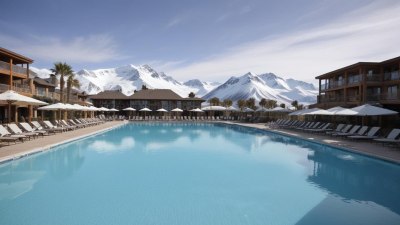The Universal Truth That You’ll Always Be Too Hot or Too Cold in a Swimming Pool
Explore the undeniable challenges of temperature balance in swimming pools and the quest for comfort.

This image was created with the assistance of Freepik
Swimming pools are often seen as the ultimate getaway, especially during the warm summer months. The refreshing blue water shimmers invitingly under the sun, promising relief and relaxation. Yet, there's a universal truth that nearly every swimmer can attest to: no matter how well you prepare, there's a good chance you will always feel either too hot or too cold when you take that plunge. In this article, we delve into the reasons behind this paradoxical experience and discuss ways to make your swimming journey more comfortable.
Understanding Temperature Perception
Before we dive into solutions, it’s important to understand how the human body perceives temperature. Our bodies are equipped with thermoreceptors that communicate with our brain, which constantly adjusts our perception of warmth or coolness based on external factors. Things like air temperature, water temperature, humidity levels, and wind all play significant roles in how we feel once we’re in a pool. But there’s more to it than simple physics; psychological factors also heavily influence our comfort levels.
Why You Feel Cold in a Swimming Pool
Many swimmers often complain about feeling cold, even when the water is warm enough to be comfortable. One major reason for this is the phenomenon of evaporative cooling. When you leave the water and air comes into contact with your wet skin, it causes rapid heat loss. The process is felt even more acutely if the ambient temperature is low or if there’s a breeze. Your body loses heat faster than it can generate, resulting in that all-too-familiar shiver.
Moreover, water conducts heat away from the body approximately twenty-five times faster than air does. As a result, even a slight drop in water temperature can make a significant difference in how warm or cold you feel while swimming. Many people expect to feel warmth in water that's even slightly cool, but oftentimes, it can feel like an icy shock.
Why You Feel Hot in a Swimming Pool
On the flip side, a swimming pool can also become unbearably hot, especially on sunny summer days. This is often due to the pool’s water temperature rising significantly after being exposed to direct sunlight for an extended period. Even if the water temperature is technically within a comfortable range, the heat from the sun can raise its perception considerably. Swimming in a warm body of water can lead to overheating, especially if you engage in vigorous activities like diving or playing games in the pool.
Furthermore, being in the water does not eliminate the risk of overheating. The body sweats to cool itself down, but the humidity in the air can interfere with this natural process. Instead of evaporating and cooling you down, sweat simply clings to your skin, leading to discomfort and an overwhelming feeling of heat, especially after exiting the water.
Proper Pool Management
To mitigate these temperature extremes, pool management comes into play. Proper heating systems can ensure the water temperature remains consistent. Many pools have heaters that regulate temperature, making an adjustable environment more feasible. Depending on the facility, you could also encounter cooling systems equipped to lower water temperature on particularly hot days.
If you’re managing a private pool, consider investing in a heater with a reliable thermostat. Knowing the pool's average temperature and adjusting your swim time accordingly can also help prevent those unpleasant dips into extreme heat or coolness.
Swimwear Selection
Another factor to consider is your choice of swimwear. Light, breathable fabrics can help keep you cool in hot pools, while thicker materials can offer some insulation in colder water. Some swimsuits are even designed to be thermal, which could be advantageous for those who are sensitive to cooler temperatures. Additionally, investing in swim accessories like rash guards or swim caps can help regulate your body temperature in various water conditions.
Timing Your Swim
Time of day also affects temperature perception. Swimming early in the morning or late in the evening often allows for a more pleasant experience; the sun isn’t too harsh, and the water might retain its heat better from the previous day. Midday swims can be blistering, so be sure to hydrate and seek shade when needed. Additionally, spending time in the water gradually allows your body to acclimatize rather than abruptly entering, minimizing temperature shock.
Acclimatization: Your Body’s Natural Adaptation
Interestingly, our bodies can acclimatize to different temperatures over time. Regular exposure to a particular water temperature can train your body to adjust its thermal comfort level. If you find a pool to be too cold initially, gradually increasing your exposure over several days and allowing your body to become accustomed can lead to a more enjoyable experience. This principle also works for hot water; eventually, your body can learn to handle warmer temperatures.
Incorporating Breaks
You can also take breaks while swimming to adjust to the temperature. Stepping out of the water intermittently allows your body to gain its natural temperature. This practice also lets you assess how hot or cold you truly feel, as sometimes constant swimming can mask your body’s signals. When swimming in warmer water, frequent breaks will enable you to cool down; in cooler water, this provides a chance to warm up as well.
Understanding Your Own Sensitivities
Each individual experiences temperature differently. Some may enjoy pleasantly warm temperatures while others may require it to be cooler to feel comfortable. Factors like age, gender, body composition, and health all play roles in these differing sensitivities. Pay attention to your own body’s signals and adjust accordingly; you might enjoy pool temperatures that others find uncomfortably cold or hot.
Community Pools vs. Private Pools
There’s a distinct difference in managing temperature perception between community pools and private pools. Community pools have larger volumes of water, making temperature regulation a greater challenge. Private pools, on the other hand, can benefit from more tailored management systems and can often be heated according to personal preferences leading to an overall heightened experience.
Creativity with Temperature
If the temperature extremes become too difficult to bear, why not get creative? Pool games and activities can help distract from temperature-induced discomfort. Consider organizing competitions, relay races, or synchronized swimming events with friends. Even simply splashing around can help regulate your internal body temperature. Involving yourself in pool activities can shift your focus away from how hot or cold you feel, creating an enjoyable atmosphere regardless of the conditions.
The Influence of Surroundings
The environment that surrounds the pool can also affect temperature perception. Natural shade from trees or awnings provides respite from harsh sunlight, while landscaped areas can create a more pleasant microclimate. You might also want to consider using umbrellas or shade sails if the pool is designed as part of an outdoor space. Alternatively, outdoor fireplaces or patio heaters can add warmth during cooler months, enhancing your comfort level.
Hydration is Key
No matter the water temperature, hydration is critical when engaging in any swimming activities. The pool environment can be deceptive; you may think you feel great, but the risk of dehydration is ever-present, especially on sunny days. Ensure that you bring water to drink during breaks, and consume fluids even if you don't immediately feel thirsty. Staying hydrated helps regulate body temperature, which in turn may make an uncomfortable experience a lot more manageable.
Feeling too hot or too cold in a swimming pool is an experience well-known by many. Factors such as water temperature, weather conditions, pool management, and personal sensitivities all contribute to this phenomenon. Understanding these elements helps swimmers take control of their swimming experience. By adapting your approach, from timing your swim to selecting appropriate swimwear and staying hydrated, you can create a more enjoyable atmosphere in and around the pool. Remember that while temperatures may fluctuate, your comfort doesn't have to.











